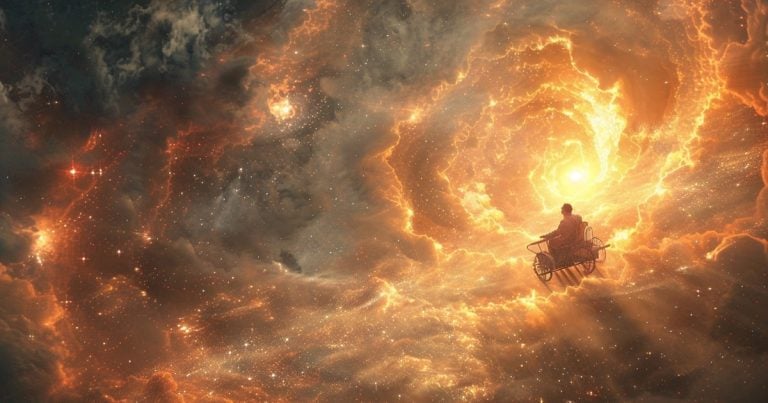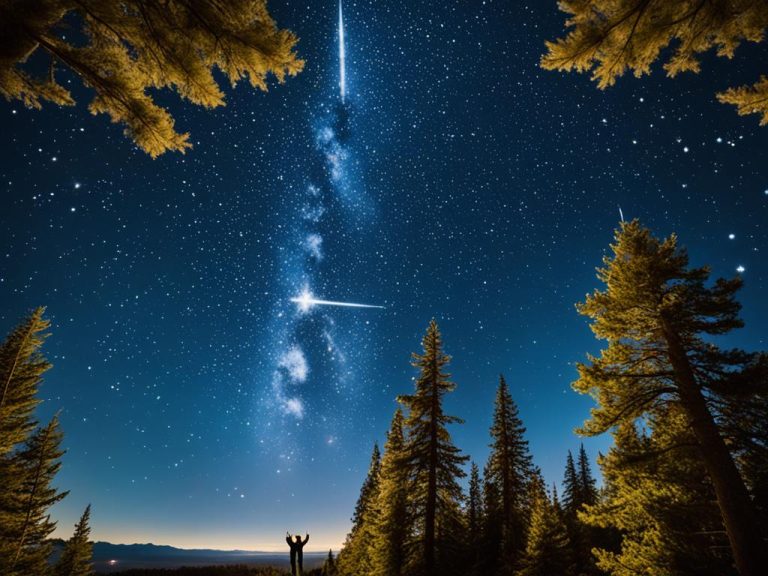Exploring the Mysteries of the Auriga Constellation
Modified: July 1, 2024 Author: International Star Registry
The night sky is like a beautiful painting filled with stars. One constellation shines brighter than the others, and that’s the Auriga Constellation. It has charmed people who look up at the stars for many years. This constellation shows us just how big and mysterious space really is.
Auriga is known as “the Charioteer” and can be seen from the north. It has stars and groups of stars that invite us to explore. Its name means “charioteer” in Latin because of its connection to a figure in old stories. With its interesting stories, important stars, and so many to see, Auriga is a place of wonder in space.

Key Takeaways:
- The Auriga Constellation is a captivating celestial wonder in the night sky.
- It is also known as “the Charioteer” and represents a mythological figure.
- Auriga Constellation offers a wealth of astronomical significance and star clusters to explore.
- Embark on a stellar experience by discovering the wonders of Auriga Constellation.
- Naming a star in the Auriga Constellation can be a unique and meaningful gift through International Star Registry.
Discover the Mythology of Auriga
The constellation Auriga has a rich history from various ancient cultures worldwide. In Greek myths, Auriga is seen as a charioteer. It shows Auriga as a protector, just like the figure Erechtheus carrying his children.
In other stories, it may have different meanings. In China, it’s the five chariots of emperors bringing bountiful harvests. Hindus see Auriga as the wise sage Prasenajit, known for leading with wisdom.
The ancient Peruvians and Aztecs, however, envisioned Auriga as a goat-herder. Stars in this constellation were their celestial goats. The animals were vital in their farming and fertility ceremonies.
Indigenous North Americans also connected with Auriga in different ways. To some, it was the bright lights of their ancestors’ campfires. To others, it appeared as the footprints of a mighty hunter. Some even thought it was a holy horse and carriage.
The myths of Auriga bring a wide range of tales to its image. To learn more about Auriga’s myths and significance, visit Universe Today and Sea and Sky.
The Astronomical Significance of Auriga
Auriga is a big part of the sky, seen in the northern hemisphere. It is close to the galactic anticenter, making it an essential spot for astronomers. They use it to study the vast Milky Way Galaxy.
It’s close to many stunning deep-sky objects. Auriga boasts amazing things like Messier objects M36, M37, and M38. These places have thousands of stars that light up the night.
Apart from star clusters, Auriga has beautiful emission nebulae. The Flaming Star Nebula is known for its bright colors and cool shapes. There’s also IC 410, a mix of gas and dust that attracts astronomers and fans alike.
When you look closer at Auriga’s deep-sky objects, you see the universe’s beauty. This exploration helps astronomers learn about stars, how they form, and the stuff between them.
Love learning about space, or just think it’s cool? Auriga is a great place to look up. Its importance and the many wonders it offers make it a must-see in the night sky.
The Stars of Auriga
Looking at the night sky, the Auriga Constellation shines beautifully. It’s the 21st biggest, covering 657 square degrees. You can see Auriga from +90° to −40° latitudes. It’s best viewed at 9 p.m. from late February to early March.
Capella stands out in Auriga, being known as α Aur. It’s the brightest there, even in the whole night sky. Capella is a pair of yellow giants with small red dwarf stars. It’s only 43 light-years away, which makes it really shine.
Menkalinan, or Beta Aur, is another amazing star. It’s about 85 light-years far. This star system shines with its white A-types and a red dwarf. Menkalinan looks bright in the night sky with a magnitude of 1.90.
Auriga is also home to Mahasim, known as Theta Aur. This double star is 173 light-years distant. It’s Alpha-2 Canum Venaticorum type variable paired with a yellow dwarf. Mahasim’s magnitude is 2.65, adding to Auriga’s beauty.
The stars in Auriga are truly fascinating, for both beginner and expert observers. If you want to know more about the Auriga Constellation, its stories, and scientific importance, click here. You can also find a detailed guide on the stars and clusters in Auriga at this link.
Locating Auriga in the Night Sky
Auriga is a well-known constellation that is always visible in the sky. It’s great for those living in the north. Start by looking for its neighbors: Camelopardalis, Gemini, Lynx, Perseus, and Taurus.
Auriga can be seen from almost everywhere, between 90 to -40 degrees latitude. That means, whether you’re in the Arctic or a bit south, you can see it. The sight of it in the night sky is always beautiful.
For a better view, use a star chart or an app. They show the sky in real-time. This makes finding Auriga and other stars much easier.
Seeing Auriga in the sky is special and interesting. It’s great for anyone who loves looking at the stars. Finding it can make your night enjoyable and fun.
Viewing the Auriga Constellation
The Auriga constellation is a stunning sight in the night sky. It’s well-known for its ten bright stars, especially Capella. It’s best seen in late autumn and winter when it’s high in the east.
Telescopes or binoculars make viewing Auriga even better. They help see the details of stars and nebulae not visible by just looking.
The brightest star in Auriga is Capella. It’s 43 light-years away and made up of two pairs of stars. This shows just how varied and amazing Auriga is.
Auriga is rich with deep-sky objects. The M36, M37, and M38 clusters are thousands of light-years away. They showcase the vastness and beauty of star formations.
To see the constellation well, head away from city lights. Look towards the west-northwest sky from late February to early March. This is when Auriga is at its best.
For both new and expert astronomers, Auriga has wonders to see. With your telescope or binoculars, enjoy its stars, clusters, and nebulae. Explore the marvels of the cosmos from the comfort of your blanket under the stars.
Click here to learn more about the Auriga constellation at AstroBackyard.
If you want to see Auriga live, The Sky Live has a great live sky map for you.
Looking to start in Auriga? Astronomy.com offers a guide for beginners. Discover it here.
Naming a Star in the Auriga Constellation
Looking for a unique and unforgettable gift? Why not name a star in the Auriga constellation? This gift, a personalized star, will be remembered for years. International Star Registry lets you buy a star for someone in Auriga after someone special. This special gift makes anyone feel extraordinary. It links their name to the beauty in the night sky.
Auriga has 159 stars brighter than magnitude 6.5, with many names to pick from. The brightest is α Aurigae, known as Capella, with a visual magnitude of 0.08. It’s the sixth brightest star you can see from Earth, and it’s 43 light-years away. Also, Auriga has stars like β Aurigae (Menkalinan), Alpha Aurigae, and θ Aurigae (Mahasim), among others. They add to Auriga’s beauty in the sky. Auriga is also home to stars that change in brightness, making it more interesting.
This constellation is a favorite among celebrities. Some celebrities that have their very own stars named in Auriga include George Bush Family, Prince, John Travolta, John Lennon & Yoko Ono, and Goldie Hawn, Daryl Hannah, Felicity Huffman, and Anthony Kiedis.
For those enchanted by the beauty of the night sky, naming a star in the Auriga constellation is a unique and heartfelt gesture. Whether to commemorate a special occasion such as a birthday, Christmas, or anniversary, or simply to express love and appreciation, naming a star allows individuals to leave a lasting legacy among the stars. Through International Star Registry, individuals have the opportunity to immortalize their loved ones or cherished memories by assigning a custom name to a star in the Auriga constellation. With a personalized star certificate and star map, recipients can marvel at their named star and its celestial companions for generations to come.

By giving someone a star’s name, you connect them with Auriga’s old myths. The name means “charioteer” in Latin and relates to stories from ancient Greece or Rome.
For more on Auriga’s stars and their stories, check out The Sky Live and Wikipedia’s list of stars in Auriga.
No matter the event, naming a star through International Star Registry is a perfect choice. Learn more and make the night extra special at starregistry.com.
The Historical Significance of Auriga
The Auriga Constellation has a long and interesting history stretching over many centuries. It was first recognized in ancient Mesopotamia, depicted as a figure of a goat-herd or shepherd holding either a scimitar or a crook. In these early times, the night sky was very important to people’s lives and beliefs.
A Greek astronomer named Ptolemy officially added Auriga to the list of constellations in the second century. His work, Almagest, made Auriga a well-known part of our sky. Ever since, people have loved looking at the stars of Auriga, finding joy in its wonders.
The story of Auriga shows how we’ve always been interested in the stars. It connects us to the past, when people first reached out to the stars with wonder and curiosity.
The Mythological Origins
Auriga’s story goes beyond history into myth, adding more mystery and beauty. In Greek myth, it represents Erichthonius, the charioteer and goat-herd.
According to legend, Erichthonius was the son of the god Hephaestus and the goddess Gaia. Because of his odd looks, Gaia hid him in a box and gave him to Athena. When Athena looked inside, she saw him and showed him to others. Some stories say a goat named Amalthea, as the star Capella, helped raise Erichthonius.
Learning about Auriga’s mythology lets us step into our ancestors’ world of beliefs. It adds wonder and a layer of imagination to the constellation, making its story richer and more exciting.
The Auriga Star Cluster
The Auriga Constellation is famous for its myths and history. It’s also home to the amazing Auriga Star Cluster. This cluster includes M36, M37, and M38.
M36, called the Pinwheel Cluster, is in the Auriga constellation. It has many bright stars, making it a stunning sight. Though smaller, it’s still wonderful to see.
M37 is the richest in stars and a true wonder of the sky. With about 500 stars, it shows off our galaxy’s beauty. You’ll see different colors, sizes, and ages of stars here.
M38, known as the Starfish Cluster, is the last part of the Auriga Cluster. It has about 100 stars and looks like a starry picture. Even with fewer stars, M38 is an incredible sight at night.
These clusters let us see the vast and beautiful universe. Anyone, from beginners to experts, can enjoy the Auriga Star Cluster. It’s a chance to marvel at the cosmos.
Discovering the Auriga Star Cluster
Use a telescope or binoculars to find the Auriga Star Cluster. You can get help online or with apps to find it. Then, take your time to see the details and beauty up close.
Seeing the Auriga Star Cluster shows us the universe’s beauty and variety. Each part of the Auriga constellation is unique. So, enjoy exploring these wonders when you look at the stars.
Exploring the Celestial Marvels of Auriga
Exploring the wonders of Auriga Constellation is a truly captivating experience. It brings together stories from old and the beauty of stars. Everyone, from beginners to experts in stargazing, will find delight in observing the sky of Auriga.
Auriga has rich and fascinating tales in Greek myth. It’s linked to the charioteer and Erichthonius, the one who made the first two-horse chariot. Learning about this myth makes stargazing even more magical.
In the sky, Auriga shines with breathtaking stars like Capella, known as the Goat Star. Capella is a vibrant part of the night sky, shining bright. It adds to the constellation’s charm.
The Flaming Star Nebula is one of Auriga’s special spots. This nebula shows in deep red and is loved by both astronomers and photographers. Its beauty is striking and unforgettable.
Auriga holds many heavenly delights, like the M36 open star cluster. This cluster is full of young stars, offering a splendid sight through a telescope. Other notable sites include M37, M38, and the Eskimo Nebula.
Ever thought of naming a star in the constelllation Auriga through International Star Registry? You get a special package with a star certificate and chart. It’s a unique way to mark a moment or celebrate someone special.

Looking up at Auriga, you’re invited to a stunning journey. It’s a chance to see celestial beauties and grow your understanding of the universe. The night sky of Auriga is waiting for you to explore.
Uncover the Mysteries of Auriga
Auriga has many secrets we’re eager to discover. Its ancient meanings and links to the stars give us a peek into what our early relatives knew. By exploring the myths, history, and the sky’s map, we journey to understand our role in the universe.
The secrets of Auriga are closely tied to ancient stories. Over time, many different cultures saw this constellation differently. The stories and signs help us learn about the thoughts and practices of the past.
Auriga’s connections go beyond stories. The way its stars are placed teaches us about the vastness and beauty of space. Looking at Auriga teaches us about the amazing connections among all cosmic things.
Auriga’s mysteries have always drawn in those who love the stars and history. The unknowns within its pattern still fascinate many. Whether you’re an expert in stars or just love the night sky, Auriga offers a chance to experience something truly special.
Unraveling the Ancient Symbols
Let’s start by exploring Auriga’s ancient meanings. Known both as a Charioteer and a Shepherd, its stories are many and varied. As we understand these symbols, we learn more about the beliefs of ancient people.
Revealing the Astronomical Significance
The deeper we go into Auriga’s mysteries, the more we learn of its star stories. Each star in Auriga adds a special touch to the sky’s beauty. By looking at their positions and qualities, we uncover secrets of the vast universe.
Learning about Auriga helps us grow and see things differently. This journey lets us see our place in the grand cosmos. For the curious, Auriga’s mysteries are an adventure in understanding our cosmic home.
Conclusion
The Auriga Constellation tells stories of mythology, history, and astronomy. Its stars and clusters light up the sky, showing us the beauty of the universe. Anyone interested in stars will find exploring Auriga unforgettable.
Dive into ancient myths, learn about its place in the sky, and discover its history. From glowing stars to star clusters, Auriga is full of amazing sights. Let its magic take you on a journey through space.
Want a unique gift? Think about naming a star in Auriga. International Star Registry lets you name a star for special moments. This way, you keep a connection to Auriga forever. Check out International Star Registry to start your adventure now.
Q: What is the Auriga Star Cluster?
What is the mythology of the Auriga Constellation?
In Greek myth, Auriga is the charioteer, like Erechtheus. In other beliefs, it’s a goat-herd or goats. In China, it’s linked to five celestial emperors’ chariots and the grain harvest.
What is the astronomical significance of Auriga?
Auriga stands opposite the Milky Way’s center. This makes it key for studying the galaxy. It has many deep-sky objects, like star clusters and nebulae.
Which are the notable stars in the Auriga Constellation?
Capella shines the brightest in Auriga. It’s followed by Menkalinan and Mahasim. Capella is the sixth brightest star in our night sky.
How can I locate the Auriga Constellation?
Look for nearby constellations like Camelopardalis and Gemini. You can also find Auriga near Taurus and others. It’s visible all year if you’re between 90 and -40 degrees latitude.
When is the best time to view the Auriga Constellation?
Late autumn and winter are best to see Auriga high in the east. Using a telescope or binoculars makes the view even better.
Can I buy a star and name it after someone in the Auriga Constellation?
Yes, visit International Star Registry to name a star after someone. It’s a unique and memorable gift.
What is the historical significance of Auriga?
Ptolemy, a Greek astronomer, spotted Auriga in the 2nd century. It’s linked back to ancient Mesopotamia, represented by a goat-herd.
The Auriga Star Cluster includes M36, M37, and M38. M37 is the most crowded with about 500 stars. These clusters show us the variety in our universe.
What can I expect when exploring the celestial marvels of Auriga?
Auriga is full of wonderful myths, history, and stars. It’s a great adventure for anyone who loves astronomy.
What mysteries can be uncovered in Auriga?
Auriga’s stories and star patterns teach us about our past. By learning more, we get closer to understanding the universe’s secrets.
What makes the Auriga Constellation so fascinating?
Auriga mixes myths, history, and science into an incredible story in the sky. Its stars and objects show us the beauty of space.
Source Links
- Auriga constellation: Facts about the charioteer – https://www.space.com/auriga-constellation.html
- Constellation Auriga – The Constellations on Sea and Sky – http://www.seasky.org/constellations/constellation-auriga.html
- Explore Auriga the Charioteer – Astronomical Society of Edinburgh – https://www.astronomyedinburgh.org/2020/11/03/explore-auriga-the-charioteer/
